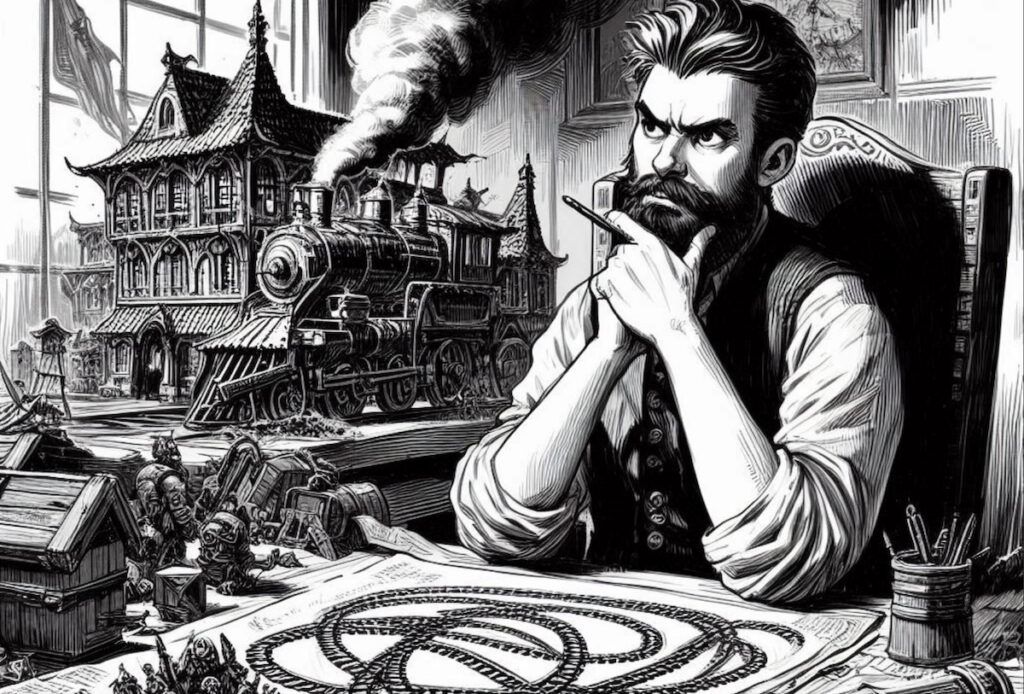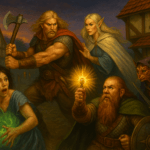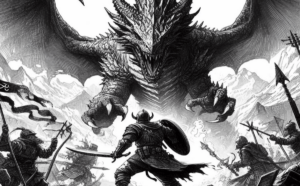
Ah, the railroad. A term that sends shivers down the spine of many a Dungeon Master (DM). We strive to craft compelling narratives, yet empower our players with meaningful choices. But achieving this balance can feel like navigating a treacherous mountain pass – one wrong turn, and you risk derailing the entire campaign.
The truth is, the “railroading bad, player agency good” dichotomy is a bit of a false dichotomy. There’s immense value in a cohesive story, and some railroading can be a necessary tool. The key lies in wielding it with finesse, ensuring the journey feels exciting and dynamic, even when there’s a set destination.
We’ve all been there: the players veer wildly off course, chasing butterflies, while the BBEG (Big Bad Evil Guy) plots world domination. Here’s how to handle the railroad with a player-centric approach:
- Plant the Seeds Early: Subtly weave plot hooks and foreshadowing into the world. Let your players discover connections, not be bludgeoned by them.
- Prepare for Deviations: Anticipate some degree of player choice. Have a toolbox of encounters, NPCs, and plot twists ready to adapt to their decisions.
- Illusion of Choice: Sometimes, offering seemingly disparate paths ultimately lead to the same critical juncture.
- Consequences, Not Punishment: If players stray too far, don’t punish them. Instead, present them with the natural consequences of their choices, perhaps forcing them to confront the BBEG earlier than planned.
- Embrace the Unexpected: The beauty of TTRPGs lies in the unpredictable. Let player actions influence the narrative. Maybe a seemingly minor choice has a ripple effect, altering the story in unforeseen ways.
Remember, the railroad tracks don’t have to be rigid steel rails. Think of them as flexible pathways, guiding the overall narrative while allowing players the freedom to explore and make meaningful choices within those boundaries.
Now, let’s get the conversation rolling! Fellow DMs, share your experiences with railroading. How do you strike a balance between story and agency at your table? What are your tips for creating a compelling narrative without feeling like you’re forcing players down a predetermined path? Let’s learn from each other and continue crafting epic adventures!
Discover more from Cresthaven RPG
Subscribe to get the latest posts sent to your email.












It was the opening session of a new campaign. The quest at hand was your basic “rescue the princess” plea. I had a big idea though… I wanted the princess to die… and I wanted the father of the princess (the most cruel king to sit on a throne in a hundred years) to be seeking vengeance upon the party… and to be an ever-threat throughout the rest of the campaign. The party was able to rescue the princess, but they were ambushed on the road returning her home.
Here is where I should have done better as a DM.
I resorted to extremely high DC saves, knowing they would all fail. They were each trapped, in one fashion or another, and watching on while I narrated a longsword through the chest of the princess. The event had to happen if the remaining months of campaign sessions were to be an exciting escape from a mad king’s wrath… but I took away all agency for that moment for the sake of the story.
Hey Shea, I feel you! That first session sting of taking away player agency is a real bummer, and we’ve all been there. Listen, the idea of killing the princess to drive the campaign is awesome, but forcing the players to just watch it happen? Yeah, that can feel like a rough ride on the story rollercoaster. Here’s how we can tweak this to make it an epic moment where they feel like heroes, not bystanders.
First off, what if the princess wasn’t necessarily a damsel in distress who gets carted off dead? Maybe the attack leaves her mortally wounded, kidnapped again, or even cursed by the attackers. This throws the rescue mission into overdrive – they gotta race against time to save her life, upping the stakes and making them super invested in her fate.
Second, imagine if the players had some clues about the danger. Maybe a cryptic prophecy whispered in a dusty tavern, a conversation they overheard about the king’s ruthlessness, or even a strange symbol on the attackers’ armor. Planting these seeds beforehand lets them make informed decisions, even if things go south.
Imagine a desperate struggle – maybe the attackers have a numbers advantage, the fight takes place on treacherous, uneven ground, or there’s a hidden factor like a rickety bridge threatening to collapse. This raises the stakes without dictating the outcome, letting them use their skills and creativity to find a way out. They might succeed in protecting the princess, or they might be forced to make tough choices under pressure. The key is to give them agency and let the dice rolls add tension, not decide the entire story.
It was the opening session of a new campaign. The quest at hand was your basic “rescue the princess” plea. I had a big idea though… I wanted the princess to die… and I wanted the father of the princess (the most cruel king to sit on a throne in a hundred years) to be seeking vengeance upon the party… and to be an ever-threat throughout the rest of the campaign. The party was able to rescue the princess, but they were ambushed on the road returning her home.
Here is where I should have done better as a DM.
I resorted to extremely high DC saves, knowing they would all fail. They were each trapped, in one fashion or another, and watching on while I narrated a longsword through the chest of the princess. The event had to happen if the remaining months of campaign sessions were to be an exciting escape from a mad king’s wrath… but I took away all agency for that moment for the sake of the story.
Hey Shea, I feel you! That first session sting of taking away player agency is a real bummer, and we’ve all been there. Listen, the idea of killing the princess to drive the campaign is awesome, but forcing the players to just watch it happen? Yeah, that can feel like a rough ride on the story rollercoaster. Here’s how we can tweak this to make it an epic moment where they feel like heroes, not bystanders.
First off, what if the princess wasn’t necessarily a damsel in distress who gets carted off dead? Maybe the attack leaves her mortally wounded, kidnapped again, or even cursed by the attackers. This throws the rescue mission into overdrive – they gotta race against time to save her life, upping the stakes and making them super invested in her fate.
Second, imagine if the players had some clues about the danger. Maybe a cryptic prophecy whispered in a dusty tavern, a conversation they overheard about the king’s ruthlessness, or even a strange symbol on the attackers’ armor. Planting these seeds beforehand lets them make informed decisions, even if things go south.
Imagine a desperate struggle – maybe the attackers have a numbers advantage, the fight takes place on treacherous, uneven ground, or there’s a hidden factor like a rickety bridge threatening to collapse. This raises the stakes without dictating the outcome, letting them use their skills and creativity to find a way out. They might succeed in protecting the princess, or they might be forced to make tough choices under pressure. The key is to give them agency and let the dice rolls add tension, not decide the entire story.